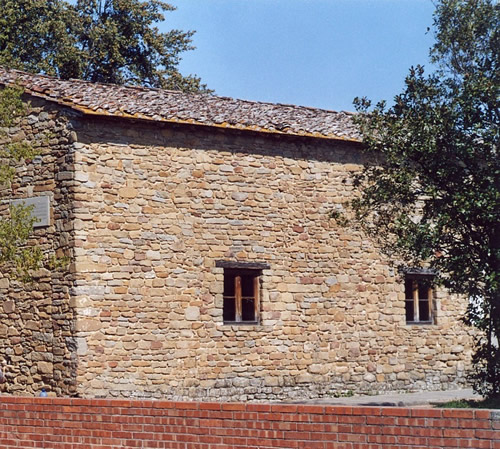Leonardo was born on 15 April 1452, "at the third hour of the night" in the Tuscan hill town of Vinci, in the lower valley of the Arno River in the territory of the Medici-ruled Republic of Florence. He was the out-of-wedlock son of the wealthy Messer Piero Fruosino di Antonio da Vinci, a Florentine legal notary, and Caterina, a peasant. Leonardo had no surname in the modern sense, "da Vinci" simply meaning "of Vinci": his full birth name was "Lionardo di ser Piero da Vinci", meaning "Leonardo, (son) of (Mes)ser Piero from Vinci". The inclusion of the title "ser" indicated that Leonardo's father was a gentleman.Little is known about Leonardo's early life. He spent his first five years in the hamlet of Anchiano in the home of his mother, then from 1457 he lived in the household of his father, grandparents and uncle, Francesco, in the small town of Vinci. His father had married a sixteen-year-old girl named Albiera, who loved Leonardo but died young. When Leonardo was sixteen his father married again, to twenty-year-old Francesca Lanfredini. It was not until his third and fourth marriages that Ser Piero produced legitimate heirs.
Leonardo received an informal education in Latin, geometry and mathematics. In later life, Leonardo recorded only two childhood incidents. One, which he regarded as an omen, was when a kite dropped from the sky and hovered over his cradle, its tail feathers brushing his face. The second occurred while he was exploring in the mountains: he discovered a cave and was both terrified that some great monster might lurk there and driven by curiosity to find out what was inside.
Leonardo's early life has been the subject of historical conjecture. Vasari, the 16th-century biographer of Renaissance painters, tells of how a local peasant made himself a round shield and requested that Ser Piero have it painted for him. Leonardo responded with a painting of a monster spitting fire which was so terrifying that Ser Piero sold it to a Florentine art dealer, who sold it to the Duke of Milan. Meanwhile, having made a profit, Ser Piero bought a shield decorated with a heart pierced by an arrow, which he gave to the peasant.

Leonardo di ser Piero da Vinci born on 15 April 1452 – 2 May 1519 was an Italian Renaissance polymath: painter, sculptor, architect, musician, mathematician, engineer, inventor, anatomist, geologist, cartographer, botanist, and writer. His genius, perhaps more than that of any other figure, epitomized the Renaissance humanist ideal. Leonardo has often been described as the archetype of the Renaissance Man, a man of "unquenchable curiosity" and "feverishly inventive imagination".
Monday, July 7, 2014
Childhood, 1452–1466
Saturday, June 21, 2014
Renaissance Man
Da Vinci has been called a genius and the archetypal Renaissance man. His talents in arguably extended far beyond his artistic works. Like many leaders of Renaissance humanism, he did not see a divide between science and art. His observations and inventions were recorded in 13,000 pages of notes and drawings, including designs for flying machines (some 400 years before the Wright brothers' first success), plant studies, war machinery, anatomy and architecture. His ideas were mainly theoretical explanations, laid out in exacting detail, but they were rarely experimental. His drawings of a fetus in utero, the heart and vascular system, sex organs, and other bone and muscular structures, are some of the first on human record.
One of da Vinci's last commissioned works was a mechanical lion that could walk and open its chest to reveal a bouquet of lilies. The famous artist died in Amboise, France, on May 2, 1519. Da Vinci's assistant and perhaps his lover, Francesco Melzi, became the principal heir and executor of his estate.
Friday, June 20, 2014
Leonardo daVinci
Born on April 15, 1452, in Vinci, Italy, Leonardo da Vinci was concerned with the laws of science and nature, which greatly informed his work as a painter, sculptor, inventor and draftsmen. His ideas and body of work—which includes "Virgin of the Rocks," "The Last Supper," "Leda and the Swan" and "Mona Lisa"—have influenced countless artists and made da Vinci a leading light of the Italian Renaissance.
Subscribe to:
Posts (Atom)


